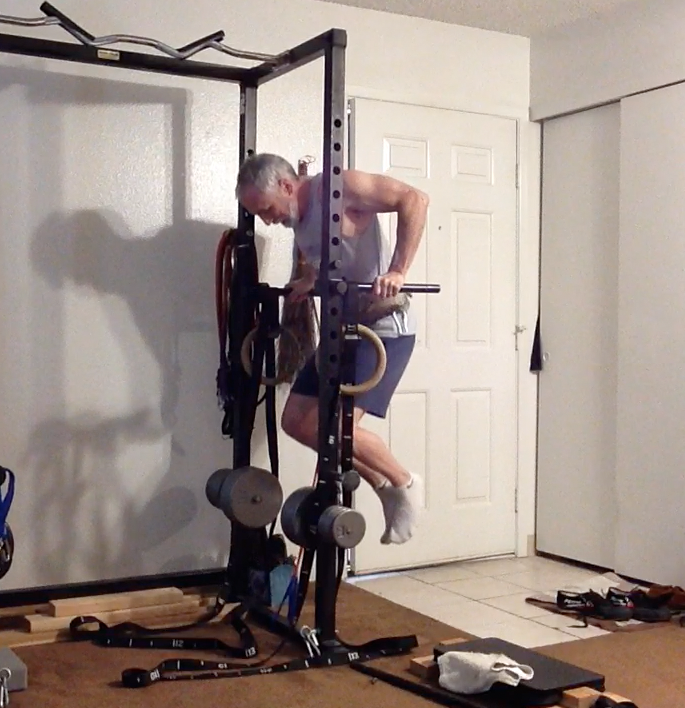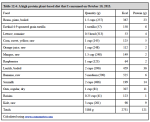The Best Chest Exercises
Horizontal Pushing Alternatives
The best chest exercises are versions of horizontal pressing that build strength and size in the pectorals (chest), deltoids, and triceps.
In the Gaining Strength Program you include one horizontal pushing exercise, chosen from parallel bar dips, loaded floor or ring push ups, barbell bench press, or X3 chest press.
Contrary to popular belief it is not necessary nor desirable to use multiple angles of pressing to properly train the pectorals. It is important to use a proper shoulder width grip to ensure full range of motion for the pectorals.
Best Chest Exercise #1: Parallel Bar Dips
Parallel bar dips are one of the best chest exercises.
Properly performed parallel bar dips are an excellent exercise for building strength and size in the pectorals, deltoids and triceps.
The parallel bar dip has been called the upper body squat. Dips are a more natural movement than bench pressing, which is responsible for so many shoulder injuries that there is a syndrome known as bench presser’s shoulder.
Wide grip bench presses are the worst offenders as they put tremendous strain on the shoulder capsule by putting the upper arm in a disadvantaged leverage position. In daily activities you would never adopt a wide grip position to push a car or other heavy object because it puts the shoulder in a weak and vulnerable position. Yet people routinely adopt wide grip bench presses, dips and push ups in the gym, which contributes to shoulder injuries. Taking a wide grip turns the best chest exercises into shoulder wreckers.
Contrary to popular belief, if you do dips properly, with hands about shoulder width apart, and a slow eccentric easing into and pausing at the bottom, you not only will not hurt your shoulders, you will gradually increase their mobility. Gradually and eventually you can get to where you can descend until your shoulders almost touch the bar/your hands. Unlike bench presses, where you actually lie down with your weight upon and impinging the movement of the scapulae, dips allow the scapulae to move freely to provide strength and stability to the shoulder joint.
In addition, the parallel bar dip and push ups are closed chain exercises – you move your body, not only an external load – which according to some research may produce superior muscle activation.
Finally, compared to bench presses, it is much easier to load parallel bar dips with resistance bands for variable resistance. Just use a hip belt and anchor the resistance bands to the bottom of the parallel bar apparatus. Resistance bands have a resistance curve similar to the strength curve of any pressing exercise. By using them you get a better training effect because the bands increase the resistance as you extend your arms, where you have the greatest strength.
Contrary to popular belief the parallel bar dip does not only activate the lower chest. Brett Contreras performed an EMG study that showed that parallel bar dips produce high activation of both upper and lower pectorals and also may activate the triceps to a greater degree than bench type presses.
|
According to Contreras’s data, weighted dips produce upper pectoral activation similar to heavy incline presses, mid pec activation similar to bench presses, lower pectoral activation greater than either bench press, and peak tricep activation similar to tricep extensions. Once you can perform 10 bodyweight dips, you should load them progressively with resistance bands or a combination of resistance bands and barbell plates. |
 |
Although the bar dip is one of the best chest exercises, not every one can do a parallel bar dip. You can use resistance bands to provide assistance to parallel bar dips, or you can choose another exercise.
Best Chest Exercise #2: Push Ups
Push ups are another excellent exercise for building strength and size in the pectorals, deltoids and triceps.
Push ups are like dips a more natural movement than bench pressing. In addition, the push up is a closed chain exercise – you move your body, not only an external load – which may produce superior muscle activation. Also, unlike a bench press the push up is performed in a plank position, which strengthens the abdominal muscles.
Further, Contreras’s data (linked above) indicates that doing push ups with heavy band resistance produces upper pectoral activation similar to heavy incline bench presses and mid pec activation similar to flat bench presses.
Finally, the push up is far safer than the barbell bench press. People have suffered serious injuries not only of the shoulder, but also of the chest or neck as a result of dropping a loaded barbell on themselves or being unable to push the barbell up from the bottom of a bench press.
All these features make push ups one of the best chest exercises.
|
One problem with push ups is finding a way to progressively load them. I recommend loading push ups progressively with elastic resistance bands. I demonstrate one method I use in the video to the right. |
Another method is to use 41" loop bands across your back and simply put your hands on top of the bands to anchor them
Research has shown that push ups loaded with adequate resistance bands produce similar strength and mass gains to barbell bench presses, but far more safely.
Floor push ups may be the best alternative to the parallel bar dip if you are unable to do dips and are able to do push ups with bands. If you can't do full push ups you can scale them by using a power rack or rings to raise your shoulders above your feet, or by using elastic bands to provide assistance.
Best Chest Exercises Summary
In the default Gaining Strength program you do either parallel bar dips or band-loaded push ups.
Recent Articles
-
Ancient Roman Soldier Diet
Apr 14, 25 05:19 PM
A discussion of the ancient Roman soldier diet, its staple foods and nutritional value, and a vegan minimalist version. -
High Protein Chocolate Tofu Pudding
Jul 01, 24 12:41 PM
A delicious high protein chocolate tofu pudding. -
Vegan Macrobiotic Diet For Psoriasis
Sep 05, 23 06:36 PM
Vegan macrobiotic diet for psoriasis. My progress healing psoriasis with a vegan macrobiotic diet. -
How Every Disease Develops
Aug 04, 23 06:22 PM
How every disease develops over time, according to macrobiotic medicine. -
Why Do People Quit Being Vegan?
Jun 28, 23 08:04 PM
Why do people quit being vegan? How peer pressure and ego conspire against vegans. -
Powered By Plants
Mar 16, 23 08:01 PM
Powered By Plants is a book in which I have presented a lot of scientific evidence that humans are designed by Nature for a whole foods plant-based diet. -
Carnism Versus Libertarianism
Dec 30, 22 01:55 PM
Carnism Versus Libertarianism is an e-book demonstrating that carnism is in principle incompatible with libertarianism, voluntaryism, and anarchism. -
The Most Dangerous Superstition Book Review
Nov 15, 22 08:46 PM
Review of the book The Most Dangerous Superstition by Larken Rose.











